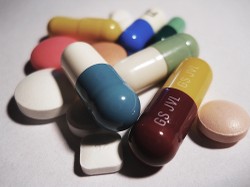The Food and Drug Administration (FDA) regulates the availability of drugs in the U.S. market. The department ensures that consumers are buying scientifically proven safe and effective drugs. It should be noted that the FDA does not test the drugs that are applying for their approval but only review clinical reports (reports may take 8 to 12 years before they are be submitted to the FDA). This article will describe the FDA approval process for drugs that are used for medical purposes.

How The FDA Approves New Medicines
by CRfan
Every new drug that makes it to your medicine cabinet has undergone an arduous process.
Preclinical Studies
This is the initial phase of the study. Here, a unique molecule is known and tested for its assumed beneficial effect. The molecule assessment involves pharmacokinetics, toxicology and dosing studies. The dosing study includes the application of the molecule to animals (such as rats, cats, rabbit and dogs) to determine the dosing limits and effects (both beneficial and adverse). The molecule under study is not tested directly on human subjects for ethical purposes.
The FDA does not care how a drug works, only that it is safe and effective.
Application of Results
Here, the testing of the drug is now extended to human subjects. After gathering significant data from the preclinical study that proves that the drug is safe and effective, the pharmaceutical company will have to apply for an Investigational New Drug Application (IND) under the FDA. The IND is like a comprehensive file about the drug. It includes the study protocol, the significant data from the preclinical study, the processes taken to manufacture the drug, the consent that will be signed by the human subjects and the criteria that will guide in choosing human subjects. The FDA will study the IND for 30 days before they give their decision to go ahead with further human testing.
Phase I
This phase is intended to study the pharmacological actions and safe dosage of the drug. Two factors are determined here: the Therapeutic Index (TI) and the No Observable Adverse-Effect Level (NOAEL). The TI is defined as the ratio of lethal dose to the effective dose while the NOAEL is a useful analog for the TI. The drug is considered dangerous and lethal if the TI score is below 20.
In this phase, only a small number of healthy human volunteers are recruited. Here, they will be asked to take the experimental drug (at its lowest level). The dosage of the drug will increase gradually while noting its half-life, protein binding, blood level, bioavailability and side effects. The half-life and protein binding effects of the drug will help in establishing proper dosing levels and dose intervals. The highlight of this phase is to understand the side effects of the drug. This is carried out by using placebo drugs and conducting a double-blind study wherein both the investigator and volunteers do not know if the drug is a placebo or not.
Phase II
This study will help determine drug efficiency. To do this, the drug will now be administered to its target patients or patients with a condition that it intends to heal. This phase is a sensitive phase because it can make or break the drug. If the safety and efficiency of the drug will not be established at this phase, it will not be allowed to proceed with other phases that include extensive human subjects.
The highlight of this phase is determining the treatment dose. The treatment dose includes the amount of the drug that should be administered to manage a certain condition (will it be 5mg? 10mg? 50mg? or maybe in mcg?) and the dosing interval (will it be every 6 hours? 8 hours? 12 hours?).
How will investigators know the "best dose"? Investigators do this by simply categorizing the subjects into low, medium and high dose groups and randomly assigning them to each group. This technique will prevent the subjects from receiving too low or too high drug dose. Furthermore, the study will be conducted in a double blind experimental set-up where the control group will be given the placebo.
Phase 2 can make or break a drug. The effectiveness of the drug, its safe dose and any side effects are highlights of Phase 2.
Phase III
Once the safety and efficiency dose is determined from phase II, the investigator would have to proceed to Phase III. This phase will now include larger numbers of human subjects. The dose that will be used here will be the production dose. This means that the drug will have the dose that will be produced worldwide and would have the dose that can treat its target disease. The dose in this phase will depend on the test results from phase II.
Included in this phase is the protocol study. Here, proper client selection, drug indication and goals of therapy are established. Proper client selection is done through identifying the inclusion and exclusion criteria for the participants. Also, the test population and control groups should be large enough to generate a significant statistical report. The groups should be variable and should include different factors such as age, gender and other variables to ensure statistical credibility. Another way to improve the statistical credibility of a drug is through conducting parallel phase III studies.
Aside from determining the drug's efficacy and safety, its mutagenic capabilities should also be studied. It is in this phase that the mutagenic potential of the drug is established through animal study. Mutagenic potential refers to the capability of the drug to cause cancer.
At the end of this phase, the drug's efficacy, safety, recommended dose, frequency, side effects, warnings and contraindications are established. However, the drug indication is only partially disclosed. This information is essential for the investigator or pharmaceutical company to proceed with the filing of a New Drug Application (NDA) to the FDA. This application requires an extensive document that scientifically describes the drug.
New uses can be found for drugs in Phase 4. Botox was originally intended for use to treat eye turns (strabismus).
Phase IV - post marketing studies
This phase is known as post-approval or post marketing studies. This phase serves many purposes such as expanding the indications of the drug or using the drug as a subject for a comparator study (a study that ascertains whether that the drug is much effective than its competitors drug).
You might also like
Anosmia - Can it be reversed ?Anosmia- loss of the sense of smell is one of the first signs of Parkinson's ...
Tudor remedies and cosmeticsYesterday I visited a Medieval Hall for a Tudor medicine and cosmetics talk. ...





 10 Tax Mistakes Business Owners Makeon 08/05/2013
10 Tax Mistakes Business Owners Makeon 08/05/2013
 Accessories For Traveling With Jeweleryon 02/12/2013
Accessories For Traveling With Jeweleryon 02/12/2013
 Stages of the Sleep Cycleon 09/23/2012
Stages of the Sleep Cycleon 09/23/2012
 The Relationship Between Fish Oil And Dry Eyeon 08/01/2012
The Relationship Between Fish Oil And Dry Eyeon 08/01/2012


Comments
I'm glad orgs like the FDA exist.
Thanks, I think it's pretty interesting too
interesting article about the procedure of drug's approval.